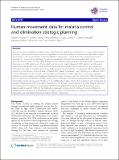| dc.contributor.author | Pindolia, Deepa K | |
| dc.contributor.author | Garcia, Andres J | |
| dc.contributor.author | Wesolowski, Amy | |
| dc.contributor.author | Smith, David L | |
| dc.contributor.author | Buckee, Caroline O | |
| dc.contributor.author | Noor, Abdisalan M | |
| dc.contributor.author | Snow, Robert W | |
| dc.contributor.author | Tatem, Andrew J | |
| dc.date.accessioned | 2013-04-09T20:12:51Z | |
| dc.date.issued | 2012 | |
| dc.identifier.citation | Pindolia, Deepa K, Andres J Garcia, Amy Wesolowski, David L Smith, Caroline O Buckee, Abdisalan M Noor, Robert W Snow, and Andrew J Tatem. 2012. Human movement data for malaria control and elimination strategic planning. Malaria Journal 11:205. | en_US |
| dc.identifier.issn | 1475-2875 | en_US |
| dc.identifier.uri | http://nrs.harvard.edu/urn-3:HUL.InstRepos:10521830 | |
| dc.description.abstract | Recent increases in funding for malaria control have led to the reduction in transmission in many malaria endemic countries, prompting the national control programmes of 36 malaria endemic countries to set elimination targets. Accounting for human population movement (HPM) in planning for control, elimination and post-elimination surveillance is important, as evidenced by previous elimination attempts that were undermined by the reintroduction of malaria through HPM. Strategic control and elimination planning, therefore, requires quantitative information on HPM patterns and the translation of these into parasite dispersion. HPM patterns and the risk of malaria vary substantially across spatial and temporal scales, demographic and socioeconomic sub-groups, and motivation for travel, so multiple data sets are likely required for quantification of movement. While existing studies based on mobile phone call record data combined with malaria transmission maps have begun to address within-country HPM patterns, other aspects remain poorly quantified despite their importance in accurately gauging malaria movement patterns and building control and detection strategies, such as cross-border HPM, demographic and socioeconomic stratification of HPM patterns, forms of transport, personal malaria protection and other factors that modify malaria risk. A wealth of data exist to aid filling these gaps, which, when combined with spatial data on transport infrastructure, traffic and malaria transmission, can answer relevant questions to guide strategic planning. This review aims to (i) discuss relevant types of HPM across spatial and temporal scales, (ii) document where datasets exist to quantify HPM, (iii) highlight where data gaps remain and (iv) briefly put forward methods for integrating these datasets in a Geographic Information System (GIS) framework for analysing and modelling human population and Plasmodium falciparum malaria infection movements. | en_US |
| dc.language.iso | en_US | en_US |
| dc.publisher | BioMed Central | en_US |
| dc.relation.isversionof | doi:10.1186/1475-2875-11-205 | en_US |
| dc.relation.hasversion | http://www.ncbi.nlm.nih.gov/pmc/articles/PMC3464668/pdf/ | en_US |
| dash.license | LAA | |
| dc.title | Human Movement Data for Malaria Control and Elimination Strategic Planning | en_US |
| dc.type | Journal Article | en_US |
| dc.description.version | Version of Record | en_US |
| dc.relation.journal | Malaria Journal | en_US |
| dash.depositing.author | Smith, David L | |
| dc.date.available | 2013-04-09T20:12:51Z | |
| dc.identifier.doi | 10.1186/1475-2875-11-205 | * |
| dash.contributor.affiliated | Smith, David L | |


